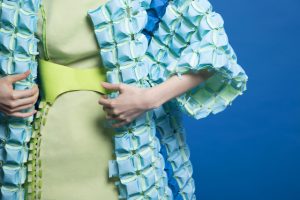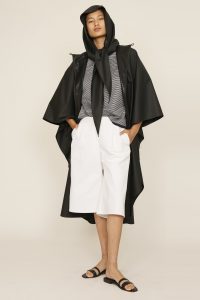After seeing the Fashion and Physique exhibit at FIT, consider how you would curate an exhibit that challenges fashion norms. Think about other exhibits that have done this as well, like FIT’s Black Fashion Designers exhibit, or even the MoMA’s Items: Is Fashion Modern?
1. Pick 5 items (include images) that you would include in your exhibit. They can be shoes, garments, accessories, magazine images, videos (if you include a video include the link), etc.
2. Include a short description of what you chose and how it challenges fashion norms. If possible, include a title for your exhibit.
For my exhibit, I would curate an exhibit for sustainable clothing that challenges fast fashion.
- My first piece is The Versalette by Seamly. This tube shaped garment was designed to be worn 30 different ways, all shown in the video link below. The great thing about the garment is that since it can be worn in so many ways, the consumer will get more uses out of it compared to an ordinary garment. They’re getting at least 30 looks in one garment; they’ll probably find more uses as they continue to use it. The multiple uses will prevent it from being thrown out as quickly as other garments are.
https://vimeo.com/67903087 - My second item is actually a whole company. Honest by is a fully transparent company. They let their consumer know everything from where they source their materials from all the way to the garment’s manufacturing process. Along with that information, they give their consumers a breakdown of the prices to explain how and why the garment costs what it does. The company is also going on what they call a “fashion fast”. Encouraged by fast fashion, the CEO, Bruno Pieters, decided to stop all production of new clothing until everything in stock is sold. He doesn’t want to bring new clothing into the world until everything his company has made is sold out.
http://www.honestby.com/ - My third item is a 3D printed dress by Dutch designer Anouk Wipprecht. I could’ve chosen any 3D printed garment. I only chose this piece because it was aesthetically pleasing to me. The main thing I wanted to focus on is how 3D printing is a sustainable way of creating garments. There’s no waste material; machines use exactly how much they need to produce an object. Also, many filaments for the printers are made out of recycled materials such as plastic milk cartons or old metal products.

- My fourth addition to my exhibit would be a garment from this zero waste collection. The textile was made through intricate fabric manipulations to give it its “modular box” look. Another feature in the collection is “a zero-waste tab-interlocking seam system.” These aspects allow “for easy disassembly and reassembly of complete garments” They also allow the consumer to customize the garment as to their aesthetic preferences.
https://www.vfiles.com/vfiles/27110

- My fifth and final item is this zero waste, one size fits all raincoat designed by Yeohlee Teng who actually went to Parsons. The piece has more than one function, which automatically gives it more time with the consumer. It can be used as a raincoat or as a cape or cloak. The hood can be manipulated into a scarf. Since it’s one size fits all, it’s made for a larger target market than several other garments because literally anyone can buy this. It’s made out of water repellent fabric which gives the user more of a reason to buy it and keep it for a long amoutn of time.
https://yeohlee.com/products/cape
